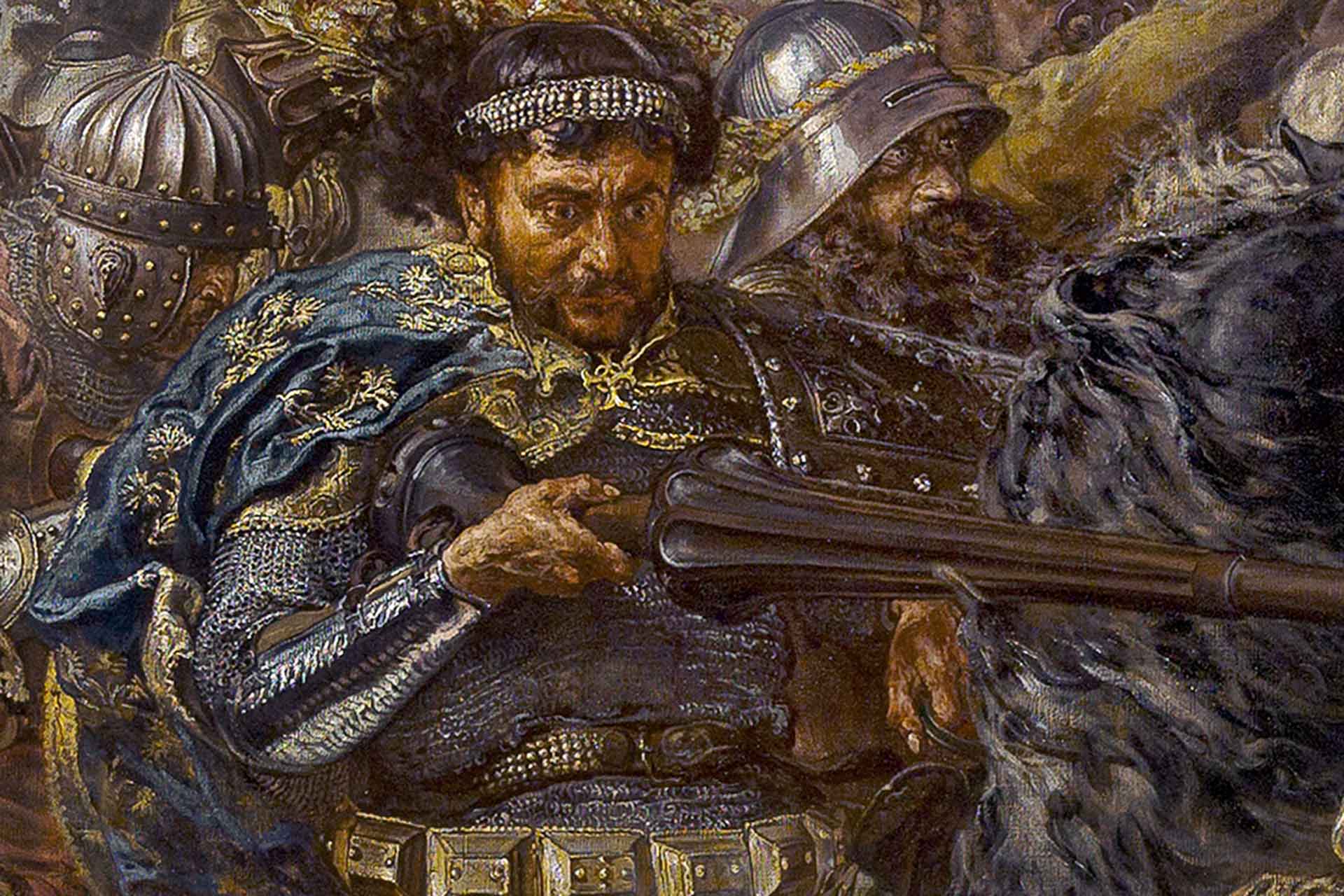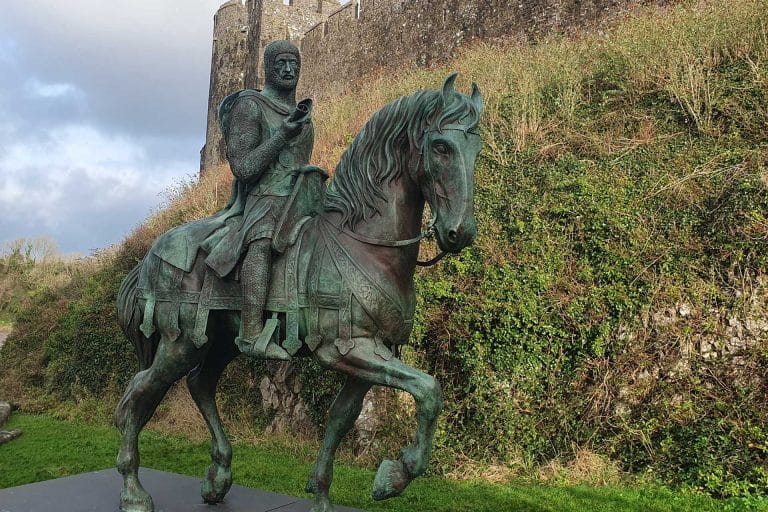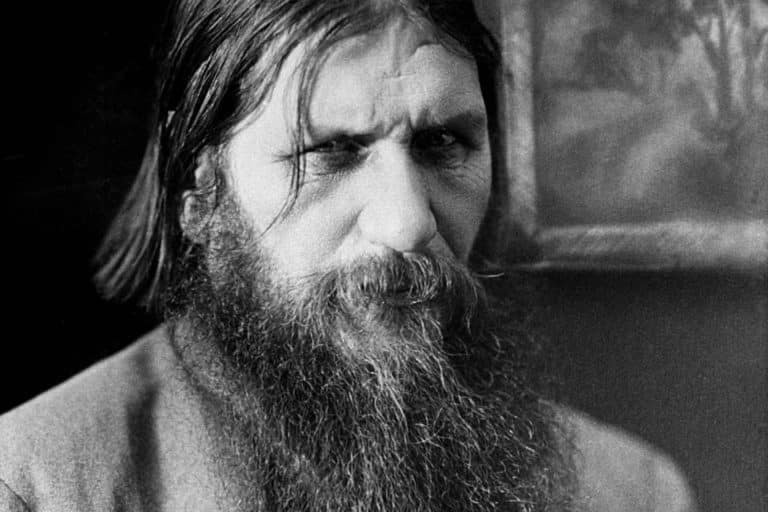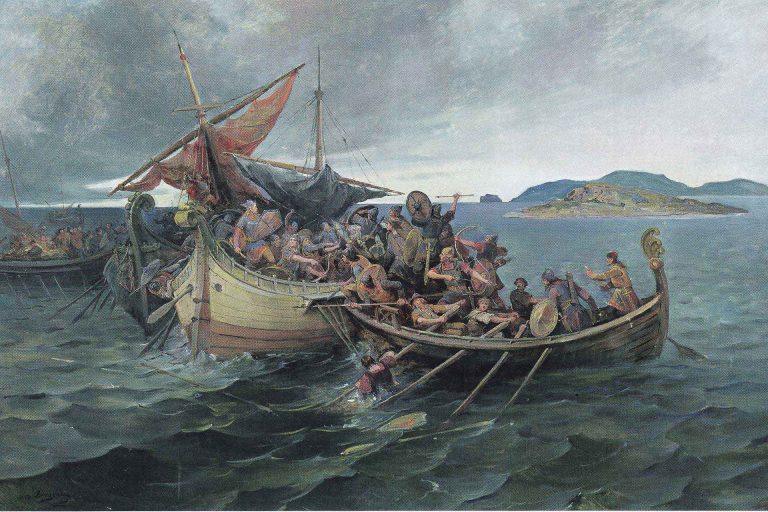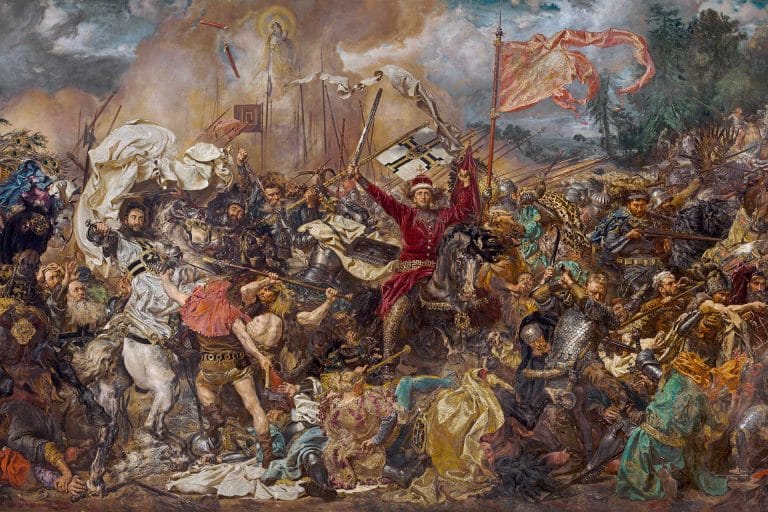Zawisza the Black: The Legendary Feats of a Heroic Polish Warrior
Zawisza the Black: The Polish Paladin of Valor
In the vibrant tapestry of European medieval history, certain names resonate with tales of valor, chivalry, and unparalleled skill in combat. Among these luminaries stands Zawisza Czarny, more commonly known to the English-speaking world as Zawisza the Black, a Polish knight whose legendary deeds transcended the boundaries of his homeland, earning him a place in the pantheon of Europe’s greatest warriors.
Born in the late 14th century, Zawisza’s life spanned an era of constant warfare and political upheaval. Yet, amidst this chaos, he emerged as a beacon of honor and integrity, representing the epitome of the chivalric code that knights aspired to uphold. As we delve into his life and accomplishments, the legacy of Zawisza the Black offers a fascinating glimpse into the challenges and triumphs of a warrior who became a symbol of Polish pride and resilience.
Zawisza Czarny’s Roots: Tracing the Early Chapters of a Warrior’s Life

Photo: Karol Karolus, CC BY-SA 4.0 https://creativecommons.org/licenses/by-sa/4.0, via Wikimedia Commons
The enigmatic tapestry of Zawisza Czarny’s lineage, like many heroes of the distant past, remains shrouded in a certain mystique. While extensive records about his ancestors and immediate heritage remain scant, this void in the record of history has only served to deepen the allure surrounding Poland’s revered knight. Delving into the fragments of his early life, it’s evident that Zawisza was a figure who drew immense pride from his roots.
The town of Garbów, nestled in the Lublin Voivodeship of eastern Poland, held a special place in his heart. Though it might not have been the grandest or most renowned place, to Zawisza, Garbów was a symbol of home, heritage, and the values he held dear. It was this unyielding pride in his origins that helped mold the unwavering spirit of the man who would soon carve his name into the pages of chivalric legend. As the tale unfolds, the profound connection between Zawisza and Garbów becomes a testament to the adage that true heroes never forget where they come from.
Zawisza the Black and the Teutonic Order: A Complex Allegiance
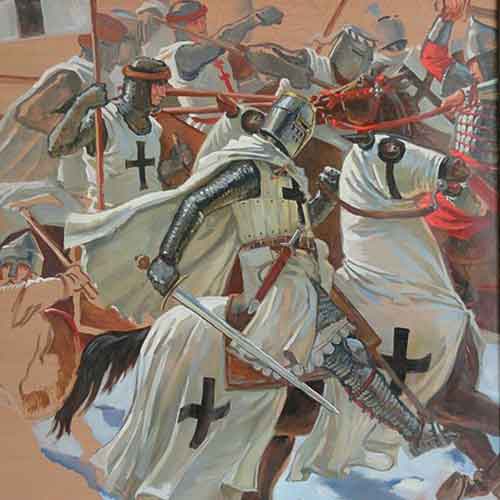
Damien, CC BY-SA 2.0 https://creativecommons.org/licenses/by-sa/2.0, via Wikimedia Commons
Among the numerous chapters in Zawisza Czarny’s storied life, his association with the Teutonic Order stands as a testament to the complex interplay of politics, faith, and personal conviction in the tumultuous era of medieval Europe. Indeed, Zawisza, like many noblemen of his time, found himself entwined in the ranks of the Teutonic Knights, an influential Catholic religious order and military force. Yet, Zawisza’s membership in the Order was not destined to last, and he ultimately renounced his association with them.
The schism between Zawisza and the Teutonic Order could be contextualized within the broader political and religious shifts of the time. The Teutonic Order’s militaristic campaign in Lithuania, even after the Lithuanian king’s conversion to Christianity, emerged as a contentious issue. It is plausible that this aggressive stance, perceived by many as being in conflict with the true essence of Christian values, led to Zawisza’s eventual disillusionment with the Order. While the exact reasons behind Zawisza’s departure remain a matter of historical speculation, what’s undeniable is that this decision further showcased the depth of his character, underlining his ability to prioritize personal convictions over institutional allegiances.
Deciphering “The Black”: The Mystery Behind Zawisza Czarny’s Epithet
The sobriquet attached to Zawisza Czarny, known as ‘The Black’, has long fascinated those who delve into the tapestries of medieval history. Its origins, though shrouded in a mix of fact and folklore, offer intriguing insights into the man behind the moniker. One of the prevalent theories suggests it’s a nod to his distinct dark hair and complexion, distinguishing him in a region where lighter features were more typical. Such descriptive titles were not uncommon during the era, akin to the way Richard the Lionheart of England was named for his courage.
Yet, the epithet might go beyond the superficial. The color black, in the medieval realm of heraldry and symbolism, stood for strength, resilience, and unwavering resolve. Given Zawisza’s renown as a formidable warrior and his undying allegiance to Poland, ‘The Black’ could well be an emblematic nod to these qualities. Furthermore, there’s speculation that the title might pertain to the dark staining or tint of his armor, a unique characteristic that would have made him easily recognizable on the battlefield and added to his mystique.
Beyond his physical attributes and armor, another layer of interpretation ties the epithet to Zawisza’s character. His possible somber disposition or the serious gravitas he brought to his roles, both in combat and diplomacy, could have contributed to the epithet. Regardless of its true roots, ‘The Black’ remains an indelible part of Zawisza Czarny’s legacy, echoing an aura of respect and reverence in Polish historiography.
Marriage, Lineage, and the Legacy of the Sulima Coat of Arms
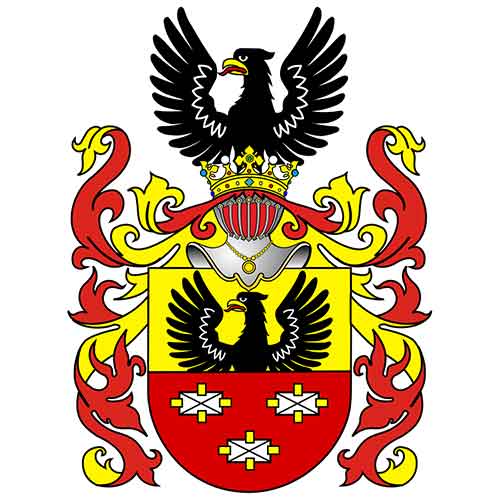
I, Voytek S, CC BY-SA 3.0 http://creativecommons.org/licenses/by-sa/3.0/, via Wikimedia Commons
Zawisza the Black’s marital life, while less sung in ballads compared to his military exploits, played a crucial role in the noble and familial tapestry of medieval Poland. He wedded Barbara of Roznow, the esteemed niece of Piotr Wysz Radoliński, the then-Bishop of Krakow. This alliance was not just a marital bond but also a union of influential families, intertwining the hero with the religious aristocracy of the era.
Their marriage was a testament to the blending of chivalric and clerical spheres, with Barbara bringing with her the prestige and influence of Bishop Radoliński. This linkage undoubtedly augmented Zawisza’s standing within the socio-political circles of Poland. Together, Zawisza and Barbara were blessed with a sizeable progeny, bearing six children. These offspring not only continued the lineage of Zawisza but also carried forth the illustrious Sulima coat of arms, emblematic of the family’s nobility and honor. This heraldic symbol, a significant mark in Polish nobility, became synonymous with the valor and reputation that Zawisza the Black had cultivated throughout his life. Through marital and familial ties, the legacy of Zawisza and the Sulima emblem persisted, echoing the warrior’s indelible mark on Polish history.
Zawisza the Black at Grunwald: Warrior and Diplomat
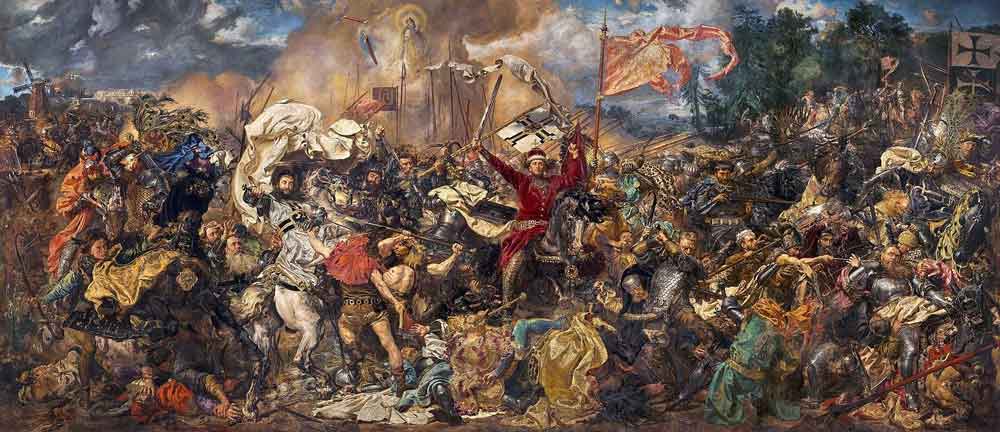
Wikimedia Commons / Public Domain
The Battle of Grunwald, which transpired on 15 July 1410, remains one of the grandest and most iconic battles in European history. This monumental clash saw the combined forces of the Polish Kingdom under Władysław II Jagiełło and the Grand Duchy of Lithuania lock horns with the Teutonic Order, a militaristic crusading order which had established a dominant stronghold in the region. The motives for the battle revolved around territorial disputes and the influence exerted upon the Baltic region by the Teutonic Knights.
Zawisza the Black was a staunch defender of the Polish crown and thus, naturally, he fought valiantly on the side of Władysław II Jagiełło during this pivotal battle. But beyond his prowess in combat, Zawisza was also renowned for his acumen in diplomacy. In the aftermath of Grunwald, with the winds of conflict still prevalent, Zawisza, alongside his close ally Stibor of Stiboricz, took on the mantle of peacemaker. They brokered a significant peace treaty between Władysław II Jagiełło of Poland and Sigismund of Luxembourg, who was then reigning as the King of Hungary. This accord came to be historically recognized as the Treaty of Lubowla. Grunwald not only showcased Zawisza’s martial expertise but also marked the beginning of his diplomatic ventures, showcasing the multifaceted nature of this legendary figure.
Zawisza at Buda: Conference and Triumph
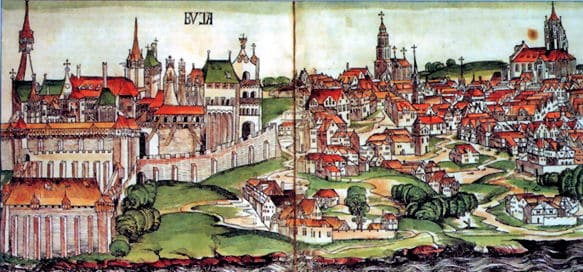
Painting / Author Unknown / Wikimedia Commons / Public Domain
The year 1412 was a significant one in the historical tapestry of Eastern Europe. At Buda, an eminent conference took place which witnessed the assembly of three paramount rulers: Sigismund of Luxembourg, Władysław II Jagiełło of Poland, and Tvrtko II of Bosnia. This high-stakes summit was convened with an overarching intent to cement alliances, address territorial disputes, and foster diplomatic ties that would shape the geopolitical landscape of the region.
Zawisza the Black, who by then was already esteemed for his martial prowess and diplomatic endeavors, was a prominent attendee. Apart from his diplomatic role, Zawisza’s reputation as an unrivaled knight was solidified at Buda. Amid the diplomatic parlays, a grand tournament was organized, drawing as many as 1,500 knights from various European realms. This event was not just a demonstration of martial skill, but also an affirmation of political and regional supremacy. Against this backdrop of intense competition and honor, Zawisza Czarny emerged as the champion, surpassing all contenders. This victory was not merely a testament to his individual skill, but also symbolized Poland’s burgeoning influence and assertiveness in continental affairs. While the conference furthered political objectives, Zawisza’s triumph in the tournament imprinted the strength and vitality of the Polish chivalric tradition in the minds of all present.
Zawisza and the Council of Constance: Standing with Jan Hus

The Council of Constance, convened between 1414 and 1418, was one of the significant events of the Late Middle Ages, aiming to resolve a range of church-related issues, most notably the Papal Schism. The council, however, also became the epicenter of discussions around religious reforms and heretical teachings, with the prominent reformer Jan Hus being the focal point of intense scrutiny.
Jan Hus, a Czech priest and theologian, ardently championed church reform, voicing opposition to several church practices and advocating for a more direct relationship between believers and the divine scriptures. His teachings, seen as radical and dangerous, earned him both followers and adversaries. It was at the Council of Constance that Hus was summoned to defend his beliefs, but instead found himself on trial for heresy. Amidst the ecclesiastical hierarchy and representatives from various European domains, there were scant few who dared to defend or even express sympathy for Hus and his teachings.
Zawisza the Black, ever the embodiment of valor and righteousness, was one of the rare voices who displayed support for Hus. While Zawisza’s motivation was not purely theological, he recognized in Hus a fellow advocate for justice, truth, and the welfare of the common people. Furthermore, Zawisza, having witnessed the political machinations and dynamics across Europe, might have seen the trial of Hus as a larger play of power and control, and thus felt compelled to stand with the embattled reformer.
Despite Zawisza’s and a few others’ support, the council’s verdict was grim for Hus. Deemed a heretic, he was excommunicated and subsequently executed by burning in 1415. His martyrdom, however, would not be in vain, as it laid the seeds for future movements, including the Hussite Wars, and set the stage for the broader Protestant Reformation.
Triumph at the Tournament of Perpignan
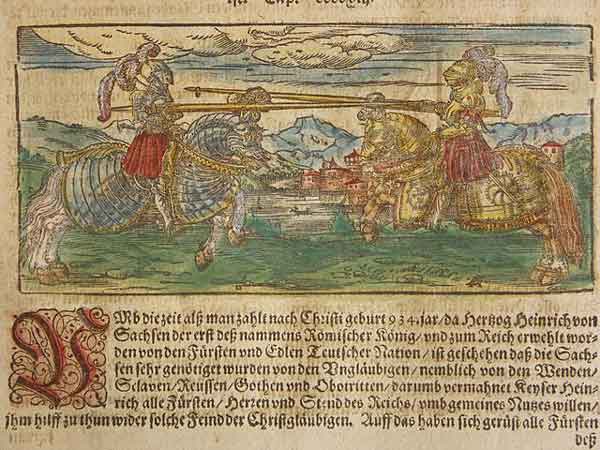
The medieval era bore witness to various jousting tournaments, but few events held as much spectacle and significance as the Tournament of Perpignan. As knights from across Europe converged in Perpignan to display their martial prowess, the stage was set for a clash of titans. Among them, the formidable Polish knight Zawisza the Black would make a mark so profound that it would be sung about for centuries.
Amidst the cheering crowd, clanging armor, and thundering hooves, Zawisza faced many worthy adversaries. However, the highlight of the tournament was his encounter with John II of Aragon & Navarre. John, apart from being a monarch, was an accomplished warrior in his own right, known for his skills in combat and leadership in the Iberian Peninsula. Their duel was more than a mere contest of strength and skill; it was a face-off between two legends of their respective lands. With the world watching, Zawisza displayed an unmatched finesse, unseating John and claiming victory. This triumph not only bolstered Zawisza’s already formidable reputation but also served as a testament to the knightly virtues of honor, skill, and determination that he embodied.
The Tournament of Perpignan was not just a series of jousts; it was a confluence of cultures, tactics, and the chivalric spirit. Zawisza the Black’s defeat of John II was the crowning glory of the event, showcasing the Polish knight’s unparalleled expertise and sealing his legacy as one of the most accomplished knights of his era. Through this victory, Zawisza the Black didn’t just win a joust; he etched his name into the lore of chivalric history.
Zawisza the Black and the Tumult of the Hussite Wars
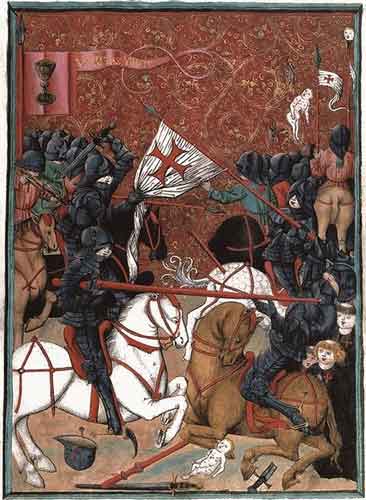
The Hussite Wars, stretching from 1419 to 1434, were a series of intense and ideologically charged conflicts, predominantly situated in the Kingdom of Bohemia. These wars stemmed from both religious and societal disagreements, arising after the execution of Jan Hus, the reformist preacher who had challenged the practices of the Roman Catholic Church. Hus’s martyrdom kindled a fire of revolt among his followers, known as the Hussites, against both the Church and monarchies that supported it. As they sought to address perceived clerical transgressions and championed the cause of reform, Bohemia became a hotbed of dissent and warfare.
While Zawisza the Black’s unwavering support for Jan Hus during the Council of Constance was well documented, Zawisza’s involvement in the Hussite Wars was less about religious fervor and more rooted in his loyalty to the Polish Crown and the broader geopolitics of Central Europe. Throughout the conflict, Zawisza demonstrated his legendary martial prowess in various skirmishes and battles. His gallantry was emblematic of a knight who, even when faced with the complex and multifaceted challenges of the Hussite Wars, never wavered from his principles and duties.
Though Zawisza’s heroics in specific battles of the Hussite Wars are not as extensively chronicled as some of his other exploits, his participation in this significant chapter of European history underscores the breadth of his career and the myriad challenges he confronted. Zawisza the Black wasn’t just a warrior; he was a symbol of chivalric ideals in an age of profound transformation and upheaval.
A Diplomatic Envoy to the Pope & The Ottoman Threat

As Poland’s renowned knight and a figure of influence, Zawisza the Black was dispatched on several diplomatic missions. One of the most significant of these endeavors involved an envoy to the Papal States. As the Medieval era saw frequent intersections of spiritual and political matters, Polish kings, like their counterparts across Europe, recognized the importance of maintaining a balanced rapport with the seat of the Catholic Church.
Given the volatile political landscape of the time, Zawisza’s mission to meet Pope Martin V was not merely a formality but carried strategic significance. One of the prevailing concerns was the relentless advancement of the Ottoman Empire into Christian territories. As the Ottomans encroached upon Europe, many Christian states perceived their march as a looming existential threat. Poland, situated at a crossroads of East and West, was particularly vulnerable. There’s historical speculation that Zawisza was sent to discuss a collaborative defense against the Ottomans, urging the Pope to unite European Christendom against the shared adversary. His credibility as a knight and his unwavering commitment to his faith made him a fitting ambassador for such crucial talks.
However, despite the numerous accounts of Zawisza’s journeys, stories of his papal interactions are regrettably scarce. Yet, the limited tales that do endure paint a picture of a diplomat who, even in the sanctified chambers of the Vatican, never shied away from expressing his convictions, particularly regarding the unity of Christendom against external threats. His diplomatic endeavors, especially his engagement with the Papal States, further cement Zawisza the Black’s multifaceted legacy as not just a warrior, but also as a statesman of notable sagacity.
The Ottoman Onslaught & The Siege of Golubac
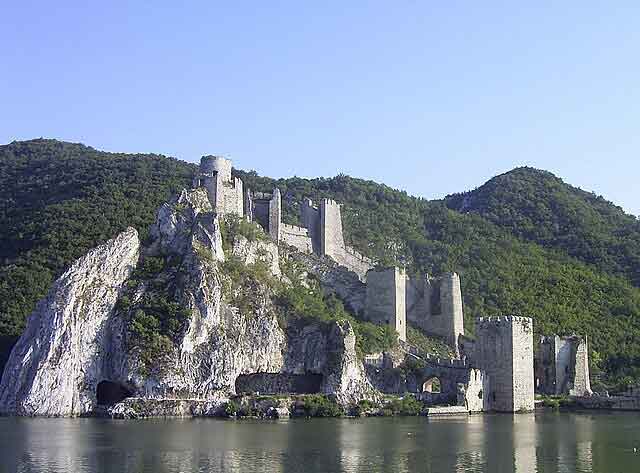
The relentless expansion of the Ottoman Empire into Europe brought it to the doorsteps of Poland and Hungary, setting the stage for several confrontations that would involve some of the most notable figures of the time, including Zawisza the Black. One significant battle during this tumultuous period was the Siege of Golubac, a fortress strategically located on the right bank of the Danube River. This stronghold, standing at the entrance of the Iron Gates gorge, was an emblem of regional power and control.
As the Ottomans laid siege to Golubac in 1428, Zawisza the Black found himself amid the chaos, defending the fortress alongside his Hungarian allies under the command of King Sigismund. The battle was fierce, with the Ottoman forces steadily gaining ground. In the midst of this desperate situation, Zawisza’s banner, a symbol of his authority and martial prowess, was at the forefront, guarding the retreating forces and offering a semblance of hope in the face of overwhelming odds. King Sigismund, recognizing the gravity of the situation and the importance of Zawisza, personally sent for him, urging him to retreat. However, Zawisza’s steadfast character and indomitable spirit came to the fore. Disheartened by what he perceived as the king’s cowardice, he is reputed to have refused the order to fall back, declaring, “There is no boat big enough to lift my honour.”
The exact circumstances of Zawisza’s end remain somewhat shrouded in mystery. Some accounts suggest he fell valiantly in combat during the siege, while others maintain he was captured and subsequently executed by the Ottomans. Regardless of the specifics, Zawisza the Black’s actions at Golubac epitomize the unwavering commitment and bravery for which he became legendary, demonstrating an unyielding devotion to honor, even in the face of impending doom.
Zawisza the Black’s Eternal Armor: A Testament to Valor at Jasna Góra

Zawisza the Black’s name, carved deeply into the bedrock of Polish history, became emblematic of unwavering valor and the quintessence of knighthood. While tales of his exploits, including the Siege of Golubac, reverberated through centuries, his legacy was tangibly preserved through the artifacts that once bore witness to his prowess. Foremost among these is his armor, a sacred relic safeguarded within the hallowed walls of the Jasna Góra Monastery.
Jasna Góra, an emblematic sanctuary for the Polish faithful, holds not only the revered image of the Black Madonna but also enshrines Zawisza’s armor, symbolizing the national spirit of resilience and heroism. This armor stands as a silent yet poignant testament to the knight’s unyielding commitment to his homeland and the values he held dear. Generations of Poles have gazed upon this relic, drawing inspiration from its steely resolve, and it serves as a reminder of the sacrifices made by heroes like Zawisza to safeguard Poland’s sovereignty.
The preservation of his armor at such a revered location underscores the profound respect and admiration the Polish people hold for Zawisza. Over the years, his life and deeds have been immortalized in literature, art, and folklore, ensuring that the name Zawisza the Black continues to inspire tales of chivalry and heroism for generations to come.

